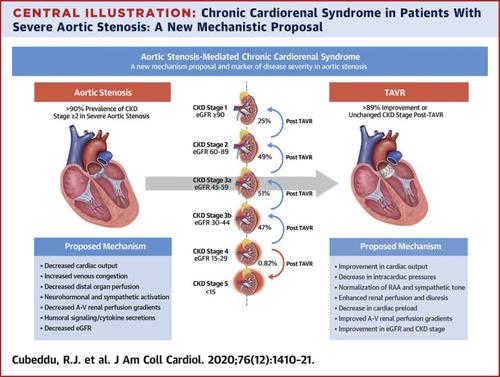当前位置:
X-MOL 学术
›
J. Am. Coll. Cardiol.
›
论文详情
Our official English website, www.x-mol.net, welcomes your
feedback! (Note: you will need to create a separate account there.)
Impact of Transcatheter Aortic Valve Replacement on Severity of Chronic Kidney Disease
Journal of the American College of Cardiology ( IF 21.7 ) Pub Date : 2020-09-01 , DOI: 10.1016/j.jacc.2020.07.048 Robert J Cubeddu 1 , Craig R Asher 1 , Ashley M Lowry 2 , Eugene H Blackstone 3 , Samir R Kapadia 4 , Maria C Alu 5 , Vinod H Thourani 6 , Michael J Mack 7 , Susheel K Kodali 8 , Howard C Herrmann 9 , Jessica Forcillo 10 , Vasilis C Babaliaros 11 , Chandan M Devireddy 12 , S Chris Malaisrie 13 , Charles J Davidson 14 , Wael A Jaber 4 , Martin B Leon 5 , Lars G Svensson 15 ,
Journal of the American College of Cardiology ( IF 21.7 ) Pub Date : 2020-09-01 , DOI: 10.1016/j.jacc.2020.07.048 Robert J Cubeddu 1 , Craig R Asher 1 , Ashley M Lowry 2 , Eugene H Blackstone 3 , Samir R Kapadia 4 , Maria C Alu 5 , Vinod H Thourani 6 , Michael J Mack 7 , Susheel K Kodali 8 , Howard C Herrmann 9 , Jessica Forcillo 10 , Vasilis C Babaliaros 11 , Chandan M Devireddy 12 , S Chris Malaisrie 13 , Charles J Davidson 14 , Wael A Jaber 4 , Martin B Leon 5 , Lars G Svensson 15 ,
Affiliation

|
BACKGROUND
The effect of transcatheter aortic valve replacement (TAVR) on kidney function stage in patients with aortic stenosis remains poorly understood. We hypothesized that in some patients, TAVR results in improved kidney function by alleviating cardiorenal syndrome. OBJECTIVES
The purpose of this study was to assess change in chronic kidney disease (CKD) stage following TAVR, identify variables associated with pre- and post-TAVR estimated glomerular filtration rate (eGFR), and assess association of post-TAVR eGFR with mortality. METHODS
Patients (n = 5,190) receiving TAVR in the PARTNER (Placement of Aortic Transcatheter Valves) 1, 2, and PARTNER 2 S3 trials between April 2007 and October 2014 were included. Pre-TAVR and procedural variables associated with post-TAVR eGFR, change in CKD stage at ≤7 days post-TAVR, and association of post-TAVR eGFR on intermediate-term mortality were assessed. RESULTS
At baseline, CKD stage ≥2 was present in 91% of patients. CKD stage either improved or was unchanged following TAVR in the majority of patients (77% stage 1, 90% stage 2, 89% stage 3A, 94% stage 3B, and 99% stage 4). Progression to CKD stage 5 occurred in 1 (0.035%) of 2,892 patients within 7 days post-TAVR. Of 3,546 patients in whom data were available, 70 (2.0%) underwent post-TAVR dialysis. Higher pre-TAVR eGFR and transfemoral approach were strongly associated with higher post-TAVR eGFR. Lower baseline and longitudinal post-TAVR eGFR were associated with lower intermediate-term survival. CONCLUSIONS
In patients with severe aortic stenosis undergoing TAVR, even with baseline impaired eGFR, CKD stage is more likely to stay the same or improve than worsen. Aortic stenosis may contribute to cardiorenal syndrome that improves with TAVR.
中文翻译:

经导管主动脉瓣置换术对慢性肾脏病严重程度的影响
背景 经导管主动脉瓣置换术 (TAVR) 对主动脉瓣狭窄患者肾功能分期的影响仍知之甚少。我们假设在一些患者中,TAVR 通过减轻心肾综合征来改善肾功能。目的 本研究的目的是评估 TAVR 后慢性肾病 (CKD) 分期的变化,确定与 TAVR 前后估计肾小球滤过率 (eGFR) 相关的变量,并评估 TAVR 后 eGFR 与死亡率的关联。方法 纳入了 2007 年 4 月至 2014 年 10 月期间在 PARTNER(主动脉经导管瓣膜放置)1、2 和 PARTNER 2 S3 试验中接受 TAVR 的患者(n = 5,190)。TAVR 前和与 TAVR 后 eGFR 相关的程序变量、TAVR 后≤7 天 CKD 阶段的变化,评估了 TAVR 后 eGFR 与中期死亡率的关联。结果 在基线时,91% 的患者存在 CKD ≥2 期。大多数患者在接受 TAVR 后 CKD 分期改善或保持不变(77% 的 1 期、90% 的 2 期、89% 的 3A 期、94% 的 3B 期和 99% 的 4 期)。在 TAVR 后 7 天内,2,892 名患者中有 1 名 (0.035%) 进展至 CKD 5 期。在可获得数据的 3,546 名患者中,70 名 (2.0%) 接受了 TAVR 后透析。较高的 TAVR 前 eGFR 和经股入路与较高的 TAVR 后 eGFR 密切相关。较低的基线和纵向 TAVR 后 eGFR 与较低的中期生存率相关。结论 在接受 TAVR 的重度主动脉瓣狭窄患者中,即使基线 eGFR 受损,CKD 分期更可能保持不变或改善而不是恶化。
更新日期:2020-09-01
中文翻译:

经导管主动脉瓣置换术对慢性肾脏病严重程度的影响
背景 经导管主动脉瓣置换术 (TAVR) 对主动脉瓣狭窄患者肾功能分期的影响仍知之甚少。我们假设在一些患者中,TAVR 通过减轻心肾综合征来改善肾功能。目的 本研究的目的是评估 TAVR 后慢性肾病 (CKD) 分期的变化,确定与 TAVR 前后估计肾小球滤过率 (eGFR) 相关的变量,并评估 TAVR 后 eGFR 与死亡率的关联。方法 纳入了 2007 年 4 月至 2014 年 10 月期间在 PARTNER(主动脉经导管瓣膜放置)1、2 和 PARTNER 2 S3 试验中接受 TAVR 的患者(n = 5,190)。TAVR 前和与 TAVR 后 eGFR 相关的程序变量、TAVR 后≤7 天 CKD 阶段的变化,评估了 TAVR 后 eGFR 与中期死亡率的关联。结果 在基线时,91% 的患者存在 CKD ≥2 期。大多数患者在接受 TAVR 后 CKD 分期改善或保持不变(77% 的 1 期、90% 的 2 期、89% 的 3A 期、94% 的 3B 期和 99% 的 4 期)。在 TAVR 后 7 天内,2,892 名患者中有 1 名 (0.035%) 进展至 CKD 5 期。在可获得数据的 3,546 名患者中,70 名 (2.0%) 接受了 TAVR 后透析。较高的 TAVR 前 eGFR 和经股入路与较高的 TAVR 后 eGFR 密切相关。较低的基线和纵向 TAVR 后 eGFR 与较低的中期生存率相关。结论 在接受 TAVR 的重度主动脉瓣狭窄患者中,即使基线 eGFR 受损,CKD 分期更可能保持不变或改善而不是恶化。











































 京公网安备 11010802027423号
京公网安备 11010802027423号